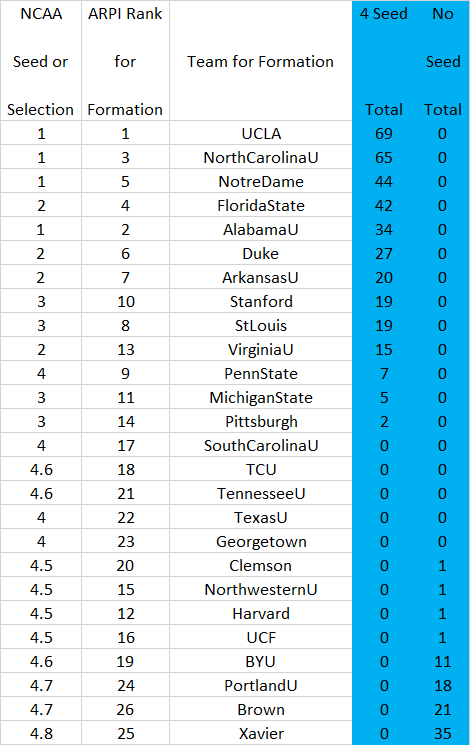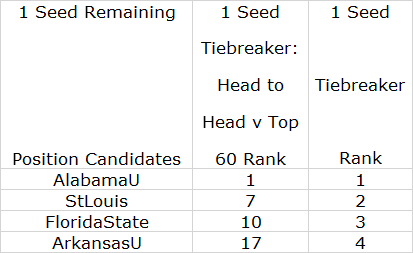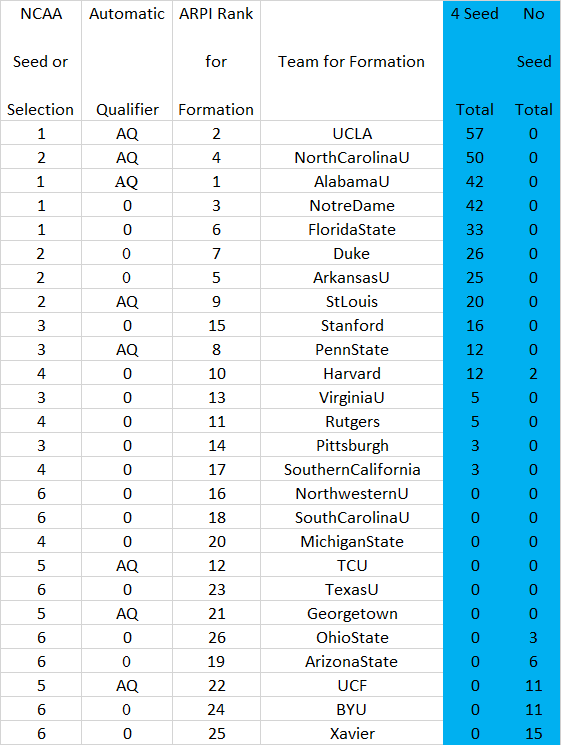In my work on non-conference scheduling in relation to the RPI and the team profile factors important during the NCAA Tournament bracket formation process, I occasionally have made this observation:
From an RPI perspective, and also from the perspective of wanting to play opponents the Committee will consider strong, you should consider the following:
The top teams from strong conferences are good opponents, both from an RPI perspective and to impress the Committee;
Once you get beyond the top teams from strong conferences, the teams lower in those conferences’ standings can be poor teams to play from an RPI perspective and because the Committee will think those teams are weaker than they really are;
On the other hand, the top teams from second and third tier conferences can be good teams to play from an RPI perspective and the Committee will think those teams are better than they really are; and
If you have two teams with RPI ranks about the same, one from a strong conference and the other from a second or third tier conference, you virtually always are better off playing the team from a second or third tier conference.
To test this observation, I did a study as follows:
For my data base, I used data from 2013 to the present (but excluding the 2020 Covid year). I started at 2013 because that was the first year following completion of the last major realignment of conference teams.
For each conference, for each final standing position within the conference, I determined:
1. Average RPI Rank for that position using the current NCAA formula;
2. Average rank for that position, under the current NCAA RPI formula, as a contributor to opponents’ strengths of schedule.
3. Average Massey Rank for that position; and
4. Average Improved RPI Rank for that position.
The Improved RPI is my revised version of the RPI. It produces ratings and ranks that are superior to the RPI by all measures I can think of (but with a more complicated formula). Massey likewise produces ratings superior to the RPI. The Massey and Improved RPI Ranks for teams generally are quite similar, but not identical. For Division I women’s soccer, the Massey and Improved RPI ranks are the best measures available of true team strength as demonstrated by team performance.
With those numbers, I then determined for each standing position in each conference:
5. The difference between average RPI Rank and average rank as a strength of schedule contributor;
6. The difference between average Massey Rank (actual strength) and RPI Rank (perceived strength per the NCAA rating system); and
7. The difference between average Improved RPI Rank (actual strength) and RPI Rank (perceived strength per the NCAA rating system).
Finally, I determined for each standing position within each conference:
8. The sum of 5 and 6; and
9. The sum of 5 and 7.
Putting all of these numbers produces the following table for the ACC:
Looking at the #1 standing position in the ACC, the Average ARPI Less SoS Contribution Ranks Difference column shows that you can expect its rank as a strength of schedule contributor to be 3.1 positions poorer than its RPI Rank says it should be. Its Average Improved RPI less ARPI Ranks Difference column shows that you can expect its Improved RPI Rank (true strength) to be 0.3 positions better than the RPI says. Its Average Massey less ARPI Ranks Difference column shows that you can expect its Massey Rank (true strength) to be 0.4 positions better than the RPI says.
If you put the strength of schedule contributor difference together with the Improved RPI difference, you get a total of -2.8. Put together with the Massey difference you get -2.7. These numbers are pretty small. What this means is that on balance, if you play the ACC #1 team in any year, their RPI Rank will be pretty close to both their true strength and what they will do for your strength of schedule portion of the RPI formula.
On the other hand, take a look at the #9 ACC team. For this team, the Average ARPI Less SoS Contribution Ranks Difference column shows that you can expect its rank as a strength of schedule contributor to be 45.9 positions poorer than its RPI Rank says it should be! Its Average Improved RPI less ARPI Ranks Difference column shows that you can expect its Improved RPI Rank (true strength) to be 14.3 positions better than the RPI says! Its Average Massey less ARPI Ranks Difference column shows that you can expect its Massey Rank (true strength) to be 16.3 positions better than the RPI says!
If you put the strength of schedule contributor difference together with the Improved RPI difference, you get a total of -60.2. Put together with the Massey difference you get -62.2. In other words, you can expect the #9 ACC team to be significantly stronger than the RPI says it is and you can expect its rank as a strength of schedule contributor within the RPI formula to be significantly poor than even its RPI says it should be.
In the table, I have used the color highlighting to show, for each conference, which standing positions within the conference are "desirable" opponents from the combined perspective of these numbers and which are "undesirable." Green highlighting indicates desirable and orange undesirable. I have designated a combined number of +10 or more as desirable and of -10 or less as undesirable. For standing positions between these two benchmarks, there is no color coding which means that there is no significant advantage or disadvantage, from the perspective of these numbers, in playing those teams -- they are Neutral from this perspective. In the Conference Teams by Rank in Conference column, the green and orange color coding appear only when both right-hand columns are that color. If only one is that color, the rank position will have no color and thus be a neutral team in terms of opponent desirability.
[NOTE: Although the table may show teams as desirable or undesirable, this is only from the perspective discussed in this article. For other reasons, including from an NCAA Tournament perspective, it may be good to play a team identified here as undesirable -- such as to play a team the RPI ranks in the Top 50.]
Thus for the ACC, if you play the #1 or #2 team in the conference, the lack of highlighting means it will be pretty much be a neutral "What you see is what you get" in terms of their RPI Rank in relation to their true strength and their rank as a strength of schedule contributor. For #3 or poorer in the conference, however, the orange highlighting means you can expect their RPI Rank and their rank as a strength of schedule contributor combined will understate their true strength.
With that explanation, the table below covers all of the conferences. It shows, in stark clarity, how the RPI discriminates in relation to conferences and their teams. You will have to scroll to the right to see the entire table. Below this table will be another that applies to geographic regions.
The next table is for teams in the four geographic areas I have identified based on the states where schools are located. The table shows averages by rank among the teams in the region. Most stark in this table is the West region. It has only a handful of rank positions that are neutral. All other positions are undesirable as opponents under the considerations I am addressing here (although they nevertheless might be desirable opponents based on other NCAA Tournament-related considerations). Again, you will have to scroll to the right to see the entire table.





















































